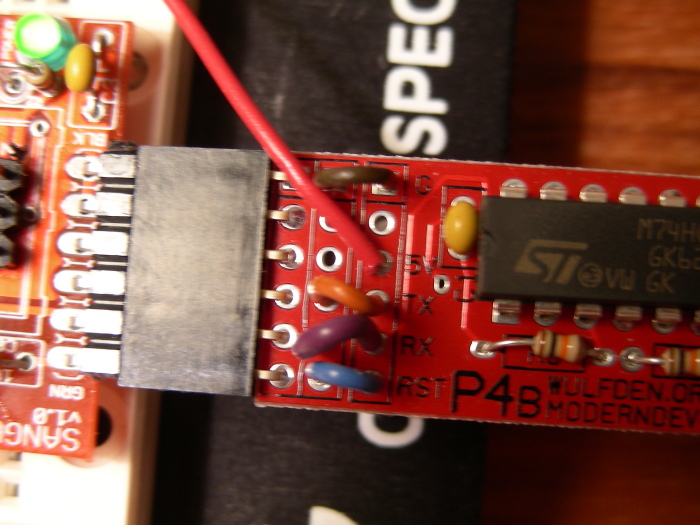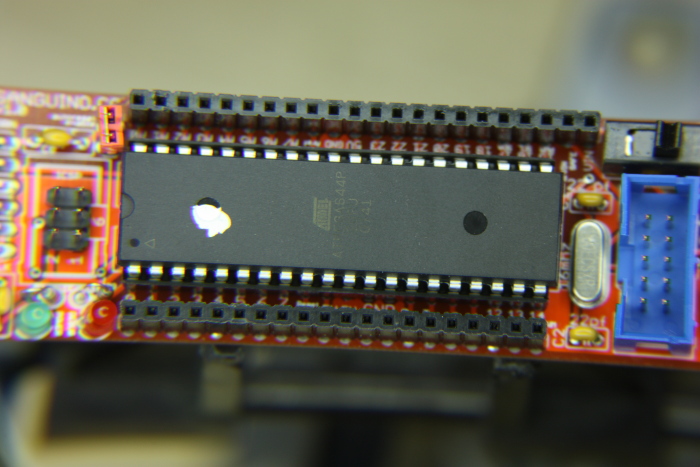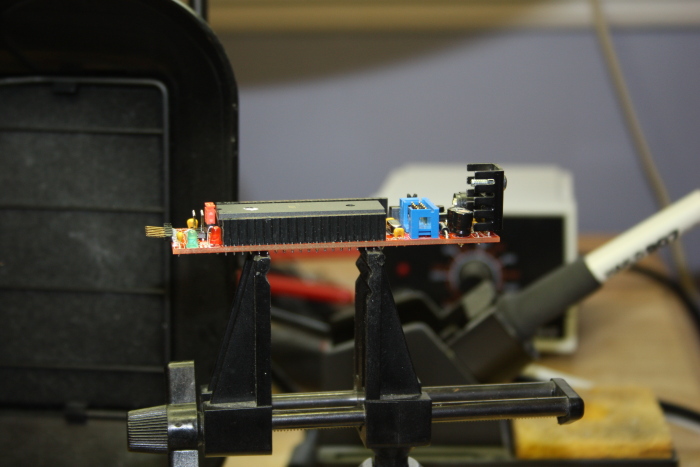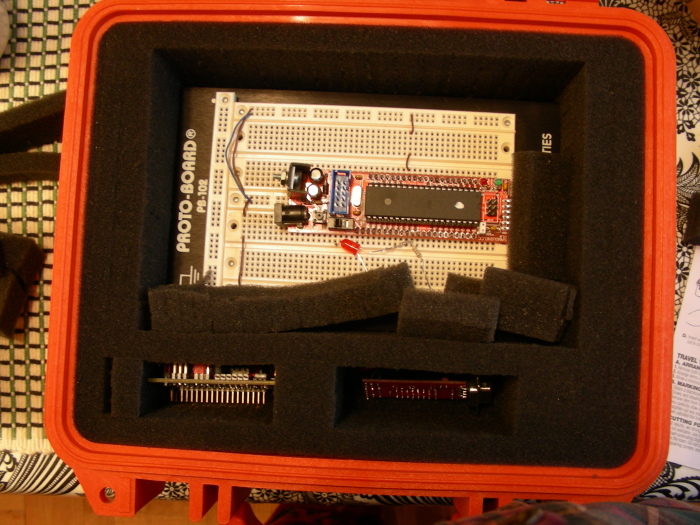Building and Using Sanguino Devices - Part II
Part I
Bob Cochran - October 2008
|

|
Programming Options For Sanguino, Further Explored
Brian Riley's P4B programmer in action. This is a very cost-effective
substitute for the FTDI cable. You plug it into the Sanguino's programming header and then
connect pin 3 (the red wire) to +5v, as shown, so that the programmer can get power. This
works great and requires only one breadboard connection, a great savings compared to the P4.
|

|
Detail of how the P4B programmer is jumpered. Also you can see the wire orientation
with respect to the programming header silkscreened legends. "BLK" means "ground" and "GRN" means
"reset". The +5v pin of the programming header on the Sanguino itself does not carry any actual power
if the power selector switch is set to "ext" for external power rather than "usb" for USB power. Hence
the red wire which runs to one of the +5v output pins of the Sanguino. The P4B, like any other device,
needs juice to run and this is how it gets it.
|

|
The Second Sanguino
I know that some day I will pry my
Sanguino out of its breadboard and break it in
the process. Maybe I won't snap it in two, but I'd surely mess up something. I bought a second
Sanguino kit from Brian and this time installed female headers instead of pin headers. This is
possibly not as good an option as using the Sanguino Breakout Shield being shown on sanguino.cc,
but it should still serve my purpose. This modification should prove easier to work with, less
expensive since it does not need a $40 dual breadboard, and have a smaller footprint overall.
I can clamp or mount this on something and wire headers and devices conveniently. I will still
need a breadboard, but perhaps a smaller size one will do. Even a mini-breadboard! The
silkscreened pin labels on the board are more difficult to read with these headers. And
without screw terminals there is always the chance a connection may come loose. Time and more
experience will tell whether this idea really works well.
|

|
Side view of the second Sanguino, showing the female headers along one
side. A small form factor like this should be easier to work with. Or use
female headers instead of pin headers.
|

|
So You Want to Travel with Your Sanguino
In the last two years, I've traveled quite a lot on business. Packing and bringing devices such as the
Sanguino is tough to do because no matter how you travel, your luggage will get bumped, mashed, rained
on, and sometimes thrown around. Leave it in a car trunk long enough in winter, and it will get frozen.
As I tried to bring more tools, components and devices with me on the road, I realized I was going to
have to improve my packing standards. Previously I'd toss everything into some cardboard boxes and put
those inside my suitcase or by themselves in my car trunk, but this doesn't work well for air or rail
travel. And if you have a breadboarded circuit you want to preserve, it won't work at all. A partial
solution is to use Pelican cases. This photo shows a Pelican 1300 case into which I've packed my
breadboard which has the Sanguino plugged into it. You can also see a smaller Freeduino device plus
the P4B programmer. I brought this on a recent trip. It worked well for car travel. Now some of my
assembled boards are protected from various forms of damage. It is still hard to preserve a
breadboarded circuit though. This represents too much bulk for rail, foot, or air travel. You can
see plainly that I don't have everything I need to set up with or modify a circuit in this one
Pelican case. So I need at least another box to carry tools and materials. Boxes are tough to
handle alone. Have you ever tried to get a suitcase, laptop carrier, and two boxes of electronics
through a New York City Transit subway farecard barrier and then up and down long banks of subway
platform access steps? And it always seems to rain the very day you have to get to Penn Station
from lower Manhattan. The Pelican 1300 case is about $48 on Amazon plus shipping. It does not appear
to allow for locking the case. I will have to figure out how to preserve whole circuits for transport
with the Pelican box.
|
|
If you have comments my email address is given below, slightly modified to confuse
spammers. You should be able to figure out how to reconstruct the address.
Robert L. Cochran ( cochranb a tt speakeasy.net )
|
|
|




